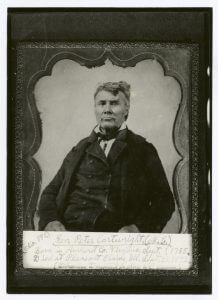Pioneering Methodist Preacher in Illinois

Peter Cartwright (1785-1872) was born in Amherst County, Virginia. The family soon moved to Logan County, Kentucky, where 16 year old Peter was converted at a camp meeting and joined the Methodist Episcopal Church. He became a preacher in 1802 and was later ordained by Francis Asbury and William McKendree. In 1812, he was appointed a presiding elder (now District Superintendent), and he served in that office for the next fifty years.
Cartwright moved from Kentucky to Illinois in 1824. In his autobiography he gave several reasons for this decision. Among them were that in Illinois he “would get entirely clear of the evil of slavery, that he could improve his financial situation and procure lands for my children as they grew up. And…I could carry the Gospel to destitute souls that had, by their removal into some new country, been deprived of the means of grace.”
Cartwright was a founding member of the Illinois Annual Conference in 1824, and remained in Illinois for the rest of his life. He was a towering figure of frontier Methodism and one of the most colorful and energetic preachers the church has produced. He was elected to 13 General Conferences and called himself “God’s Plowman.”
Despite (or perhaps because of) his own background, Cartwright tirelessly promoted Methodist education and helped found McKendree College (Lebanon), MacMurray College (Jacksonville), and Illinois Wesleyan University (Bloomington).
He also was active in state affairs. Twice a member of the Illinois legislature, he ran for the United States Congress in 1846, but was defeated by the Springfield lawyer, Abraham Lincoln.
In 1808, Cartwright married Frances Gaines; together they had two sons and seven daughters, one of whom, Cynthia, died on the journey to Illinois.
The present Cartwright United Methodist Church began in 1824 as a class in the Cartwright home. In 1838, Cartwright donated land and $300 towards the construction of a log chapel where the congregation worshipped until 1853. By that time, the church had grown so much that it had to divide into two congregations. One moved two miles west and built the Bethel Methodist Episcopal Church (which was torn down in 1953). The other moved into the new village of Pleasant Plains and the current building was constructed in 1857. Two additions have been made, but the sanctuary is nearly the same as it was during Cartwright’s time.
Taken with permission from Heritage Landmarks: A Traveler’s Guide to the Most Sacred Places in The United Methodist Church, by the General Commission on Archives and History. For more information, see http://www.gcah.org/research/travelers-guide/peter-cartwright-united-methodist-church




